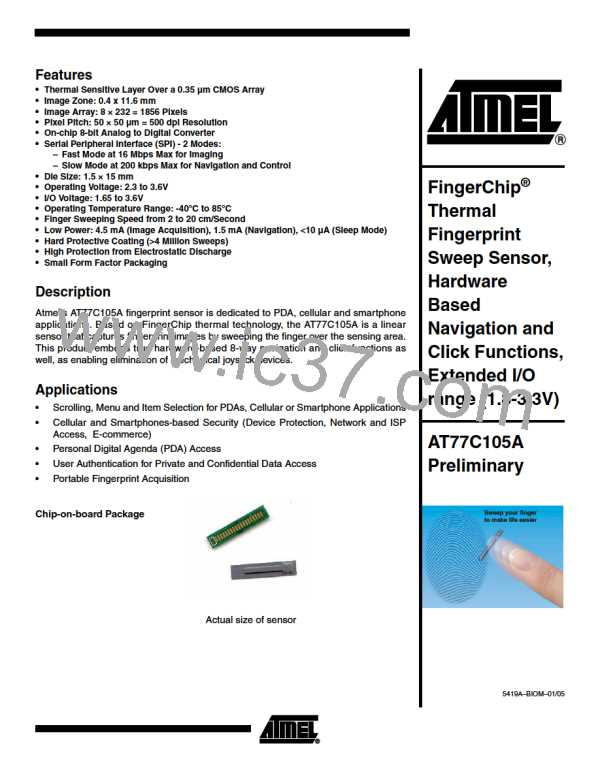SPI Interface General Description
Two communication busses are implemented in the device:
•
The control interface, a slow bus that controls and reads the internal registers
(status, navigation, control...).
•
The pixels’ acquisition interface, a fast bus that enables full pixel acquisition by the
host.
A synchronous Serial Port Interface (SPI) has been adopted for the two communication
busses.
The SPI protocol is a slave/master fullduplex synchronous serial communication. This
protocol uses three communication signals:
•
•
•
SCK (Serial Clock): the communication clock
MOSI (Master Out Slave In): the data line from the master to the slave
MISO (Master In Slave Out): the data line from the slave to the master
The slaves are selected by an input pin SS/ (Slave Select). A master can communicate
with several slaves.
The word length of the transferred data is fixed to 8 bits. The Most Significant Bit (MSB)
is sent first. For each 8-bit transfer, 8 bits are sent from the master to the slave and 8
bits transferred from the slave to the master. Transfers are still synchronized with the
communication clock (SCK). Only the host can initialize transfers. To send data, the
slave must wait for an access from the master. When there is no transfer, a clock is not
generated.
Figure 8. One Master with Several Slaves
SS/3
Slave #3
SS/1
Slave #1
SS/2
Slave #2
Master
SCK
MISO
MOSI
When a master is connected with several slaves, the signals SCK, MISO and MOSI are
interconnected. Each slave SS is driven separately. Only one slave can be selected, the
others have their MISO tri-stated and ignore MOSI data.
The SS/ signal falls a half-period before the first clock edge, and rises a half-period after
the last clock edge.
Clock Phase and Polarity During phase zero of the operation, the output data changes on the clock’s falling edge
and the input data is shifted in on the clock’s rising edge. In phase one of the operation,
the output data changes on the clock’s rising edge and is shifted in on the clock’s falling
edge.
22
AT77C105A [Preliminary]
5419A–BIOM–01/05

 ATMEL [ ATMEL ]
ATMEL [ ATMEL ]